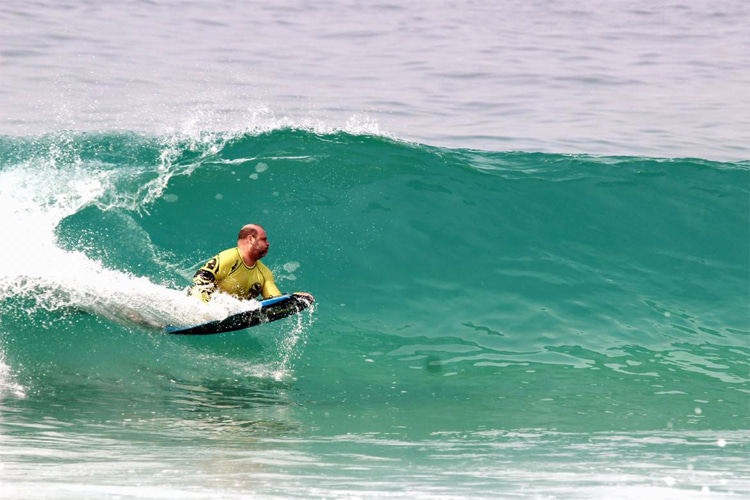The master's division is a category that has been growing across all sports.
Several TV programs are rescuing this essence and its idols, whether in surfing, skateboarding, or hang-gliding.
And despite being one of the "youngest" of extreme sports, bodyboarding is no different.
I was always passionate about sports.
I started bodyboarding at the beginning of 1986 during the Morey Boogie fever, exactly when Brazil sent its first delegation to compete in the Morey Boogie International Professional Championships.
The team was comprised of Marcus Cal Kung, Claudio Marques, Guto de Oliveira, Marco Salgado, Xandinho, and Andréa Ferreira, an athlete from Niterói who was representing France in that event.
These were my first idols and references in the sport.
In that year of 1986, Claudio Marques finished tenth and was the best non-Hawaiian competitor.
In the 1980s, Rio de Janeiro dominated bodyboarding in Brazil - all athletes, judges, and event managers were high-class.
The Associação de Bodyboarding do Estado do Rio de Janeiro (ABBERJ) was a reference for all other states, but also internationally.
In addition to those mentioned above, my list of idols of that time had names like Kiko Ebert, Kiko Pacheco, Ugo Corti, Paulo Esteves, Guilherme Tâmega, Marcelo Siqueira, Carlos Sequeira, Marcelo Paiva, but also Mariana, Isabela Nogueira, Glenda Kozlowski, Stephanie Pettersen, and Daniela Freitas.
This was our "elite carioca" and national troop from the 1980s.
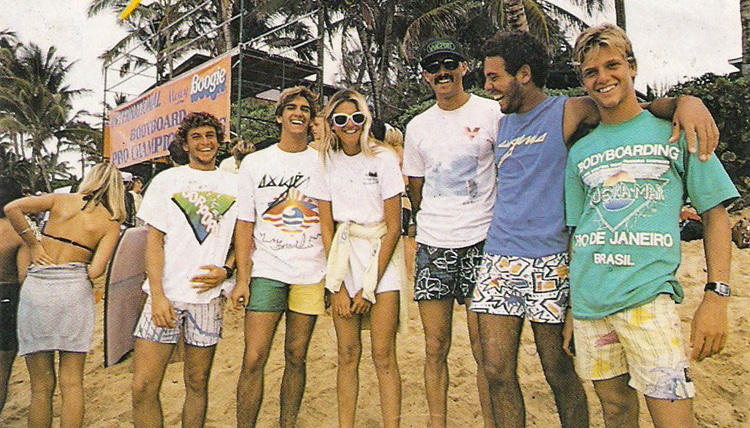
The Retirement Era
The sport went through several phases - from the glamor of the 1980s to the economic crises of the 1990s, including the extinction of ABBERJ and ABRASB, giving way to FEBBERJ and CBRASB, respectively.
During this period, several idols retired.
Some of them were really young and pursued other personal and professional journeys. With the crisis that was hurting the sport, they didn't see future perspectives on how to make a living from bodyboarding.
In 1999, Style Magazine, the main Brazilian bodyboarding publication at the time, through its editor-in-chief, Alexandre Iglesias, also an athlete from the 1980s, promoted the first master event for athletes aged over 25 or 26.
The contest was held at São Conrado Beach.
The final had Fernando Telles "Russo," Julio Cavaleiro, Claudio Marques, and Ley Silva in first, second, third, and fourth places, respectively.
I was always nostalgic. I always wanted the new generation to know the history and revere the idols of yore.
In 2002, when I was president of Associação Macaense de Bodyboarding (AMB), talking to Edmar Rezende, president of FEBBERJ and CBRASB, about the intention of creating a master category in an attempt to rescue and bring the idols back into the water, he allowed me to run an experimental division for athletes over 28 years old at the first stage of FEBBERJ' State Amateur event in 2003, in Macaé.
Unfortunately, there were few participants, but the seed was planted.
And on that same year, Julio Cavaleiro asked me to put up a master event in São Conrado, which attracted 40 athletes.
Fabio Aquino won it in a final that also had Rodolfo Fiuza, Billy Barros, and Stephan Stamm.
This was the starting point for the creation of the "Bodyboarding Master Series" movement.
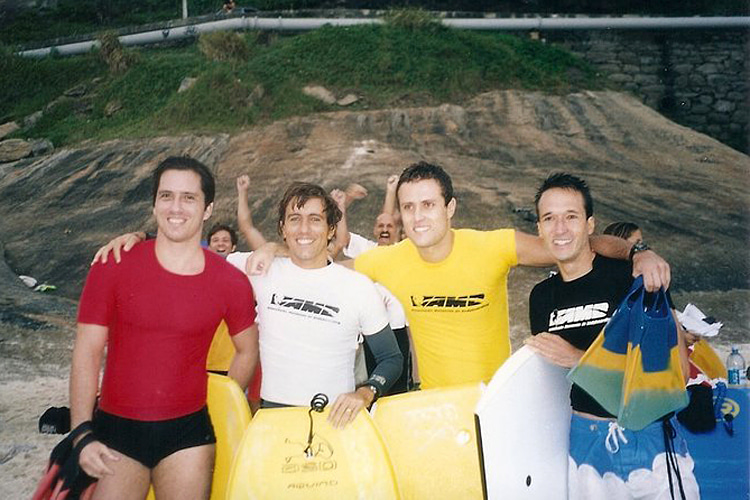
The Comeback
From 2003 to 2005, several individual competitions were run, some organized by myself outside Rio, others by Julio Cavaleiro in Rio, and others by Gabriel Fonseca in the Lagos region.
The contest had a different format and rounds, in which the highest-scoring riders were divided into two semifinals and the grand final.
In this period, we saw a strong comeback of several athletes, and the seed was starting to grow in other associations.
In 2005, with the suspension of the "Bodyboarding Master Series," some organizers added master divisions to the events.
We had the now-extinct OVNI circuit run by Walter Andrade and Leonardo Teixeira.
And there was also the first G80 of Bodyboarding in 2005, run by Arthur Steele, which gathered several riders from Niterói.
The competition rode the wave of nostalgia and saw Gugu Barcellos taking first place, followed by Rodrigo Correa, Paulo Esteves, and Marcelo Madeira.
Following this iconic event, Arthur decided to revive ABBN, working with the core divisions and, whenever possible, strengthening the master category.
That was until 2010.
In 2012, with the world circuit being hosted for the first time in Itacoatiara, we thought of holding a master competition the week before the main event.
I challenged Arthur Steele to organize the event, and he promptly accepted.
The event was held in perfect six-foot waves with more than 30 athletes over 30 years old.
Many of them were former Brazilian champions and top athletes of the time with several titles and good results in national and international events.
The idea was to have a contest for teams similar to the "tag-team" format.
In a chat with Arthur, he suggested a formula where the whole team would go into the water together instead of having one team against the other.
The format was well accepted, as the idea was to make the undertrained athletes feel comfortable sharing the lineup with better-trained athletes.
At the same time, we wanted to make it possible for master athletes who had never competed professionally to be there in the water, side by side with their 1980s idols.
The format was improved in the subsequent stages.
We created new rules that made the team format more viable, friendly, welcoming, and simultaneously, with all the competitiveness that is still there in many riders.
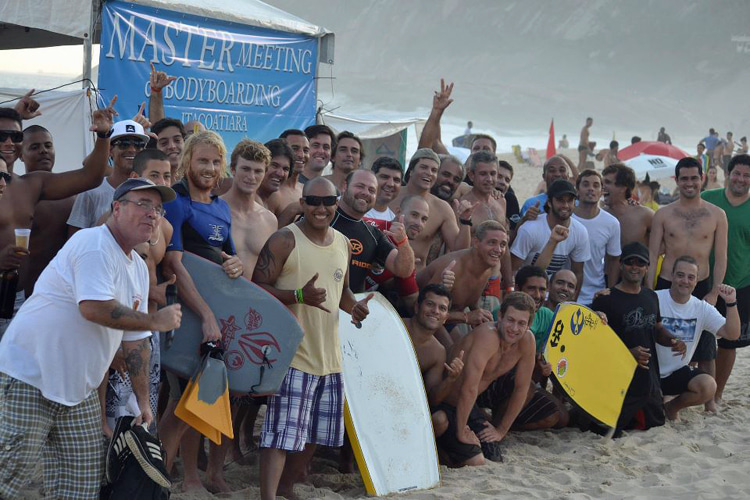
The Rio Bodyboarding Master Series Movement
The 2012 stage in Itacoatiara kicked off the creation of the "Rio Bodyboarding Master Series" movement.
The project was led by Fabio Aquino and me.
We divided the tasks and worked from 2012 to 2014, making a structured circuit at a state level, with a defined calendar and five stages in optimal conditions for the sport - Arraial do Cabo, Leme, São Conrado, Secreto, and Joatinga.
We always had good photographers and videographers, generating excellent content for all participants and supporters.
This was also the main goal of these events - to generate media for all athletes and sponsors and to increase the return on investment made in the registration fee.
In 2013 and 2014, we even gave away tickets to Chile to the newly crowned champions.
Guilherme Correa won the 2013 and 2014 masters division (over 35 years old), and Bruno "Pão" Rodrigues won the 2014 senior category (30-34 years).
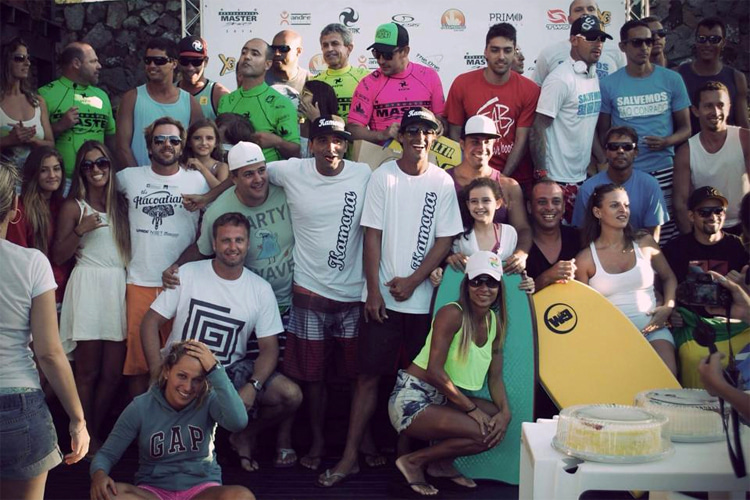
The Shock Master Challenge
In 2015, I decided to take a break from running the circuit, focusing only on special events.
That was the time when, together with Rodrigo and Guilherme Correa, Itacoatiara locals, and frequent riders at Shock, we decided to merge hunger with the will to eat.
With their will to do it and my experience in conducting events, we created the Shock Master, an invitation-only event for Itacoatiara locals.
So, that's when the first Shock Master Challenge was born.
Also, in 2015, with no leadership available to run the Rio Master circuit, they asked me to re-organize the events, and so we did two separate stages at the end of the year in São Conrado and Joatinga.
In 2016, we resumed the Rio Bodyboarding Master Series circuit with several athletes from other parts of Brazil running the events and promoting events with our competitive format.
In Espírito Santo, Marcelo Rocha and Marcelo Miranda, who had already worked with FEBBEES, put up excellent master stages and rescued several Capixaba athletes that were already retired.
Our seed also led to the creation of the Macaé Master movement in 2015.
Run by Robson Lins, Bruno Mussi, Alexandre Marçal, and Eric Schuller, the event had the same format as the Rio Master Series, bringing together only master athletes from Macaé. It was a huge success.
In 2016, they held an excellent open circuit with four stages.
In 2017 and 2018, Sérgio Rangel and Ewerton Miranda took over the organization of the Macaé Master, which is today one of the best master circuits in the state.
In 2011, and also in Niterói, Robson Costa created UBBN to strengthen the sport in the region after Arthur Steele retired in 2010.
In 2017, he adds the Master category to UBBN events, brings back the G80 of Bodyboarding, and promotes an excellent Rio Master.
In 2018, Hugo Pessanha, master bodyboarder and event organizer in Campos, runs Eco Bodyboarding, a superb circuit inspired by the Rio Master format.
A Bright Future
At the beginning of 2018, I told all athletes that it would be my last year as the head of the organization of the Rio Master Series circuit.
After almost 30 years of collaboration and managing events, it was time to retire and just play with the crew in and out of the water.
With several other Master circuits being held throughout the State of Rio (Macaé, Niterói, and Campos), the division is now one of the strongest in the sport.
It is also part of the Brazilian Bodyboarding Circuit.
At the end of 2018, Marcello Pedro organized the Bodyboard Legends, a commemorative event that gathered almost 60 bodyboarders from all over Brazil in Barra da Tijuca.
In 2019, several stages ran master divisions, and there was also a state circuit kicking off in Itacoatiara.
We continue to hold master competitions. This is how we work and contribute to the perpetuity of our sport.
Master will never die.
Words by Rodrigo Monteiro de Andrade | Bodyboarder
